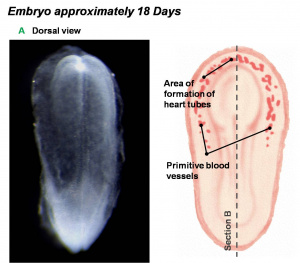Talk:Intermediate - Primordial Heart Tube
--Phoebe Norville 10:28, 22 September 2009 (EST) Content added (not formatted):
The heart primordium arises predominantly from splanchnic mesoderm in the cardiogenic region of the trilaminar embryo. The cardiogenic region can be thought of as bilateral fields that merge cranially to form a horseshoe shaped field. During the third week of development, angioblastic cords develop in this cardiogenic mesoderm and canalise to form bilateral heart tubes.
Lateral folding of the embryo brings the heart tubes into the ventral midline allowing them to fuse to form a single primordial heart tube. Fusion of the heart tubes begins cranially and extends caudally.
After fusion, particular constrictions and dilations appear in the heart tube forming the following divisions:
- Truncus arteriosus
- Bulbus cordis
- Primordial ventricle
- Primordial atrium
- Sinus venosus
Note that by the end of the fourth week (day 22), coordinated contractions of the heart tube are present and push blood cranially from the sinus venosus.
Heart Layers
Myocardium: forms from splanchnic mesoderm surrounding the pericardial coelom. Additional myocardial cells are added to the outflow tract during heart looping. Cardiac Jelly: gelatinous connective tissue separating the myocardium and heart tube endothelium. Endocardium: forms from the endothelium of the heart tube. Epicardium: develops from mesothelial cells arising from the sinus venosus which spread cranially over the myocardium.

